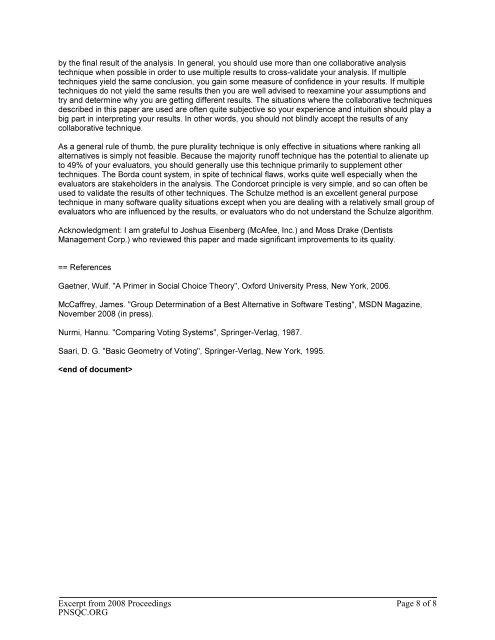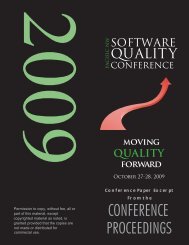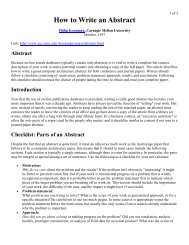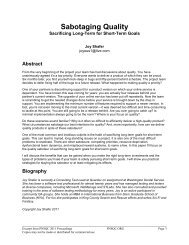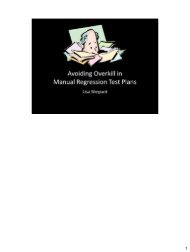Permission to copy, without fee, all or part of this material ... - PNSQC
Permission to copy, without fee, all or part of this material ... - PNSQC
Permission to copy, without fee, all or part of this material ... - PNSQC
Create successful ePaper yourself
Turn your PDF publications into a flip-book with our unique Google optimized e-Paper software.
y the final result <strong>of</strong> the analysis. In general, you should use m<strong>or</strong>e than one collab<strong>or</strong>ative analysis<br />
technique when possible in <strong>or</strong>der <strong>to</strong> use multiple results <strong>to</strong> cross-validate your analysis. If multiple<br />
techniques yield the same conclusion, you gain some measure <strong>of</strong> confidence in your results. If multiple<br />
techniques do not yield the same results then you are well advised <strong>to</strong> reexamine your assumptions and<br />
try and determine why you are getting different results. The situations where the collab<strong>or</strong>ative techniques<br />
described in <strong>this</strong> paper are used are <strong>of</strong>ten quite subjective so your experience and intuition should play a<br />
big <strong>part</strong> in interpreting your results. In other w<strong>or</strong>ds, you should not blindly accept the results <strong>of</strong> any<br />
collab<strong>or</strong>ative technique.<br />
As a general rule <strong>of</strong> thumb, the pure plurality technique is only effective in situations where ranking <strong>all</strong><br />
alternatives is simply not feasible. Because the maj<strong>or</strong>ity run<strong>of</strong>f technique has the potential <strong>to</strong> alienate up<br />
<strong>to</strong> 49% <strong>of</strong> your evalua<strong>to</strong>rs, you should gener<strong>all</strong>y use <strong>this</strong> technique primarily <strong>to</strong> supplement other<br />
techniques. The B<strong>or</strong>da count system, in spite <strong>of</strong> technical flaws, w<strong>or</strong>ks quite well especi<strong>all</strong>y when the<br />
evalua<strong>to</strong>rs are stakeholders in the analysis. The Cond<strong>or</strong>cet principle is very simple, and so can <strong>of</strong>ten be<br />
used <strong>to</strong> validate the results <strong>of</strong> other techniques. The Schulze method is an excellent general purpose<br />
technique in many s<strong>of</strong>tware quality situations except when you are dealing with a relatively sm<strong>all</strong> group <strong>of</strong><br />
evalua<strong>to</strong>rs who are influenced by the results, <strong>or</strong> evalua<strong>to</strong>rs who do not understand the Schulze alg<strong>or</strong>ithm.<br />
Acknowledgment: I am grateful <strong>to</strong> Joshua Eisenberg (McA<strong>fee</strong>, Inc.) and Moss Drake (Dentists<br />
Management C<strong>or</strong>p.) who reviewed <strong>this</strong> paper and made significant improvements <strong>to</strong> its quality.<br />
== References<br />
Gaetner, Wulf. "A Primer in Social Choice The<strong>or</strong>y", Oxf<strong>or</strong>d University Press, New Y<strong>or</strong>k, 2006.<br />
McCaffrey, James. "Group Determination <strong>of</strong> a Best Alternative in S<strong>of</strong>tware Testing", MSDN Magazine,<br />
November 2008 (in press).<br />
Nurmi, Hannu. "Comparing Voting Systems", Springer-Verlag, 1987.<br />
Saari, D. G. "Basic Geometry <strong>of</strong> Voting", Springer-Verlag, New Y<strong>or</strong>k, 1995.<br />
<br />
Excerpt from 2008 Proceedings<br />
<strong>PNSQC</strong>.ORG<br />
Page 8 <strong>of</strong> 8


